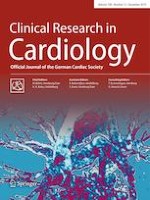Introduction
Methods
Study population and design
Follow-up
Laboratory methods
The GRACE score
Statistical methods
Results
Baseline demographics
All (N = 1314) | Non-AMI (N = 1006) | AMI (N = 308) | p value | |
|---|---|---|---|---|
Age (years) | 64.0 (51.0, 75.0) | 63.0 (49.0, 74.0) | 68.0 (58.0, 76.0) | < 0.001 |
Male (%) | 846 (64.4) | 639 (63.5) | 207 (67.2) | 0.26 |
BMI (kg/m2) | 26.1 (23.6, 29.3) | 26.0 (23.6, 29.3) | 26.2 (23.6, 29.4) | 0.76 |
Hypertension (%) | 885 (67.6) | 649 (64.8) | 236 (76.9) | < 0.001 |
Hyperlipoproteinemia (%) | 502 (38.2) | 359 (35.7) | 143 (46.4) | < 0.001 |
Diabetes (%) | 179 (13.8) | 124 (12.5) | 55 (18.1) | 0.018 |
Former smoker (%) | 386 (29.5) | 297 (29.6) | 89 (29.0) | 0.89 |
Current smoker (%) | 331 (25.3) | 241 (24.0) | 90 (29.3) | 0.073 |
History of CAD (%) | 442 (33.6) | 322 (32.0) | 120 (39.0) | 0.028 |
eGFR (ml/min for 1.73 m2) | 76.7 (59.1, 92.5) | 79.6 (61.3, 94.0) | 67.8 (52.2, 83.6) | < 0.001 |
Symptom onset ≥ 6 h (%) | 693 (57.1) | 535 (58.2) | 158 (53.7) | 0.2 |
hs-TnI I 0 h (ng/L) | 6.8 (3.1, 21.9) | 5.0 (2.5, 10.3) | 88.1 (18.2, 945.7) | < 0.001 |
suPAR 0 h (ng/ml) | 3.3 (2.3, 4.8) | 3.2 (2.3, 4.7) | 3.5 (2.4, 5.1) | 0.066 |
Prediction of all-cause mortality according to suPAR levels
Model 1: HR (95% CI) | p value | Model 2: HR (95% CI) | p value | Model 3: HR (95% CI) | p value | Model 4: HR (95% CI) | p value | |
|---|---|---|---|---|---|---|---|---|
All patients | ||||||||
Second quartile vs. first quartile of suPAR | 0.25 (0.03, 2.24) | 0.22 | 0.21 (0.02, 1.91) | 0.17 | 0.21 (0.02, 1.85) | 0.16 | 0.20 (0.02, 1.76) | 0.15 |
Third quartile vs. first quartile of suPAR | 4.15 (1.39, 12.41) | 0.011 | 2.83 (0.93, 8.58) | 0.067 | 2.75 (0.90, 8.44) | 0.076 | 2.66 (0.86, 8.19) | 0.089 |
Fourth quartile vs. first quartile of suPAR | 12.60 (4.54, 34.97) | < 0.001 | 7.06 (2.46, 20.28) | < 0.001 | 4.80 (1.63, 14.15) | 0.005 | 4.52 (1.51, 13.48) | 0.007 |
Only AMI patients | ||||||||
Second quartile vs. first quartile of suPAR | No events | n.a. | No events | n.a. | No events | n.a. | No events | n.a. |
Third quartile vs. first quartile of suPAR | 6.23 (0.77, 50.63) | 0.087 | 4.21 (0.51, 34.71) | 0.18 | 3.44 (0.40, 29.41) | 0.26 | 3.37 (0.39, 29.02) | 0.27 |
Fourth quartile vs. first quartile of suPAR | 18.05 (2.43, 134.24) | 0.0047 | 10.43 (1.37, 79.54) | 0.024 | 6.60 (0.84, 51.72) | 0.072 | 6.22 (0.79, 49.14) | 0.083 |
GRACE score












